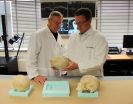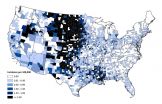(Press-News.org) CAMBRIDGE, Mass--Researchers have succeeded in creating a new "whispering gallery" effect for electrons in a sheet of graphene -- making it possible to precisely control a region that reflects electrons within the material. They say the accomplishment could provide a basic building block for new kinds of electronic lenses, as well as quantum-based devices that combine electronics and optics.
The new system uses a needle-like probe that forms the basis of present-day scanning tunneling microscopes (STM), enabling control of both the location and the size of the reflecting region within graphene -- a two-dimensional form of carbon that is just one atom thick.
The new finding is described in a paper appearing in the journal Science, co-authored by MIT professor of physics Leonid Levitov and researchers at the National Institute of Standards and Technology (NIST), the University of Maryland, Imperial College London, and the National Institute for Materials Science (NIMS) in Tsukuba, Japan.
When the sharp tip of the STM is poised over a sheet of graphene, it produces a circular barrier on the sheet that "acts as a perfect curved mirror" for electrons, Levitov says, reflecting them back toward the center of the circle. This controllable reflectivity is similar, he adds, to so-called "whispering gallery" confinement modes that have been used in optical and acoustic systems -- but these have not been tunable or adjustable.
"In optics, whispering gallery modes are known and useful," Levitov says. "They provide high-quality resonances. But the usual problem in optics is they're not tunable." Similarly, previous attempts to create quantum "corrals" for electrons have used atoms precisely positioned on a surface, which cannot be reconfigured easily.
The confinement in this case is produced by the boundary between two different regions on the graphene surface, corresponding to the "p" and "n" regions in a transistor. In this case, a circular region just beneath the STM tip takes on one polarity, and the surrounding region the opposite polarity, creating a controllable circular junction between the two regions. Electrons inside sheets of graphene behave like particles of light; in this case, the circular junction acts as a curved mirror that can focus and control the electrons.
It's too early to predict what specific uses might be found for this phenomenon, Levitov says, but adds, "Any resonator can be used for a variety of things."
This electron resonator combines several good features. There's clearly something special about having tunability and also high quality at the same time."
Because the new system is based on well-established STM technology, it could be developed relatively quickly into usable devices, Levitov suggests. And conveniently, the STM not only creates the whispering gallery effect, but also provides a means of observing the results, to study the phenomenon. "The tip does double-duty in this case," he says.
This could be a step toward the creation of electronic lenses, Levitov says -- "a concept that intrigues graphene researchers." In principle, these could provide a way of observing objects one-thousandth the size of those visible using light waves.
Electronic lenses would represent a fundamentally different approach from existing electron microscopes, which bombard a surface with high-energy beams of electrons, obliterating any subtle effects within the objects being observed. Electron lenses, by contrast, would be able to observe the ambient low-energy electrons within the object itself.
This could make it possible to study "subtle things about how charge carriers behave at a microscopic level, that you can't see from the outside," Levitov says.
The new work by Levitov and his colleagues provides one piece of such a system -- and potentially of other advanced electro-optical systems, he says, such as negative-refraction materials that have been proposed as a kind of "invisibility cloak." The new whispering-gallery mode for electrons is part of a toolbox that could lead to a whole family of new quantum-based electron-optics devices. It could also be used to create highly sensitive sensors, since such resonators "can be used to enhance your sensitivity to very small signals," Levitov says.
INFORMATION:
The research team also included graduate student Joaquin Rodriguez-Nieva from MIT; Yue Zhao, Jonathan Wyrick, Fabian Natterer, Nikolai Zhitenev, and Joseph Stroscio from NIST; Cyprian Lewandowski from Imperial College London; and Kenji Watanabe and Takashi Taniguchi from NIMS.
For years, scientists have been puzzled by the presence of short stretches of genetic material floating inside a variety of cells, ranging from bacteria to mammals, including humans. These fragments are pieces of the genetic instructions cells use to make proteins, but are too short a length to serve their usual purpose. Reporting in this week's Cell, researchers at Rockefeller have discovered a major clue to the role these fragments play in the body -- and in the process, may have opened up a new frontier in the fight against breast cancer.
Specifically, Sohail Tavazoie ...
Every inch of our body, inside and out, is oozing with bacteria. In fact, the human body carries 10 times the number of bacterial cells as human cells. Many are our friends, helping us digest food and fight off infections, for instance. But much about these abundant organisms, upon which our life depends, remains mysterious. In research reported May 7 in Cell, scientists at Rockefeller finally crack the code of a fundamental process bacteria use to defend themselves against invaders.
For years, researchers have puzzled over conflicting results about the workings of a ...
EAST LANSING, Mich. - Much like a finger leaves its own unique print to help identify a person, researchers are now discovering that skull fractures leave certain signatures that can help investigators better determine what caused the injury.
Implications from the Michigan State University research could help with the determination of truth in child abuse cases, potentially resulting in very different outcomes.
Until now, multiple skull fractures meant several points of impact to the head and often were thought to suggest child abuse.
Roger Haut, a University Distinguished ...
PULLMAN, Wash.--Washington State University researchers say the popularity of bamboo landscaping could increase the spread of hantavirus, with the plant's prolific seed production creating a population boom among seed-eating deer mice that carry the disease.
Richard Mack, an ecologist in WSU's School of Biological Sciences, details how an outbreak could happen in a recent issue of the online journal PLOS One.
Bamboo plants are growing in popularity, judging by the increased number of species listed by the American Bamboo Society. Some grow in relatively self-contained ...
WASHINGTON -- Can a true, robust global health framework be created to help prevent tragedies like Ebola while at the same time allow countries to meet everyday health needs?
Georgetown University global health and law experts say it can be done, and in a special issue of "The Lancet" focusing on global health security, they propose specific priorities to transform a fragmented health system into a "purposeful, organized" framework with national health systems at its foundation and an empowered World Health Organization at its apex.
"The Ebola epidemic in west Africa ...
The west African Ebola epidemic has rekindled interest in global health security, but it has also highlighted a troubling lack of political commitment to public health, and it is far from clear whether the crisis will be enough to rejuvenate global health security, say leading global health experts writing in The Lancet.
Through a series of essays [1], the review, which is published as part of a special issue on global health security, explores different perspectives on the wider lessons that can be drawn from the outbreak, including how it has demonstrated the importance ...
Your genes may influence how sensitive you are to emotional information, according to new research by a UBC neuroscientist. The study, recently published in The Journal of Neuroscience, found that carriers of a certain genetic variation perceived positive and negative images more vividly, and had heightened activity in certain brain regions.
"People really do see the world differently," says lead author Rebecca Todd, a professor in UBC's Department of Psychology. "For people with this gene variation, the emotionally relevant things in the world stand out much more."
The ...
For faster, longer-lasting water filters, some scientists are looking to graphene --thin, strong sheets of carbon -- to serve as ultrathin membranes, filtering out contaminants to quickly purify high volumes of water.
Graphene's unique properties make it a potentially ideal membrane for water filtration or desalination. But there's been one main drawback to its wider use: Making membranes in one-atom-thick layers of graphene is a meticulous process that can tear the thin material -- creating defects through which contaminants can leak.
Now engineers at MIT, Oak Ridge ...
BOULDER--New research has identified correlations between weather conditions and the occurrence of West Nile virus disease in the United States, raising the possibility of being able to better predict outbreaks.
The study, by researchers with the National Center for Atmospheric Research (NCAR) and the Centers for Disease Control and Prevention (CDC), finds strong correlations across much of the country between an increased occurrence of West Nile virus disease and above average temperatures in the preceding year. The scientists also find that precipitation influences ...
Latin American women in Los Angeles County are twice as likely as white women to contract cervical cancer, according to the Los Angeles County Department of Public Health, and are significantly less likely to be educated about the causes of the disease or to be screened for it.
That needs to change, say USC researchers, who are finding ways to make it happen.
"Latinas are the ones most at risk and yet health communication campaigns still essentially target white women," said Sheila Murphy, professor at the USC Annenberg School for Communication and Journalism.
Murphy ...

